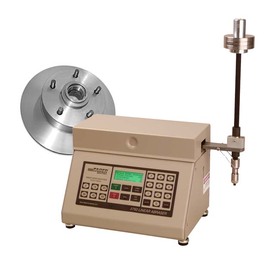Automotive Brake Rotors
Depth of Wear Evaluations Assist in Quantifying Brake Rotor Treatments
Situation:
Vehicles subjected to extreme driving conditions (such as police cruisers) typically require brakes and rotors to be replaced on a frequent basis. Therefore, increasing the life of a brake rotor can have a significant impact on maintenance costs and the time the vehicle must be taken out of service for repairs. Unfortunately, the cost to perform a life study on a test stand or in actual usage can be extremely expensive. Precision Fleet Brakes (now known as Fleet Physics), a supplier of automotive brake rotors, found this out when they were trying to analyze the wear performance of different heat treatments. They approached Taber to explore cost effective R&D solutions that would differentiate the treatments and help them to identify viable options.
Analysis:
Precision Fleet Brakes' objective was to identify an easy-to-use test instrument that could produce measurable wear on the brake rotor surface. Taber’s initial recommendation was to make test plaques out of the same material as the brake rotors, allowing different cyrogenic treatment options to be evaluated on the Taber Rotary Abraser. This approach was not practical, nor was cutting test coupons out of the rotors. To avoid costs associated with sample preparation and to prevent any change to the material properties caused by cutting the samples, the customer required the instrument to be capable of testing an actual brake rotor.
 Due to its versatility, the solution was Taber Industries Linear Abraser. Preliminary tests were conducted using Calibrade Wearasers to help identify which abradant was most appropriate. The initial testing utilized the H-18 and H-22 Wearasers, but both wore at a rapid rate without generating much specimen wear. Utilizing previous experience from Rotary Abraser tests on steel, the H-10 Wearaser was selected. This proved to be a successful option, and with additional tests Taber identified an ideal test set-up for the customer.
Due to its versatility, the solution was Taber Industries Linear Abraser. Preliminary tests were conducted using Calibrade Wearasers to help identify which abradant was most appropriate. The initial testing utilized the H-18 and H-22 Wearasers, but both wore at a rapid rate without generating much specimen wear. Utilizing previous experience from Rotary Abraser tests on steel, the H-10 Wearaser was selected. This proved to be a successful option, and with additional tests Taber identified an ideal test set-up for the customer.
Although the weight loss is not significant enough to measure, this approach can be quantified via depth of wear (for this example, 0.005” to 0.010” was typical) or high resolution imaging.
Benefit:
In utilizing the Linear Abraser, data generated allowed Precision Fleet Brakes to directly compare different cyrogenic treatments for their brake rotors. This low cost testing approach provided enough information to rank the performance of the different treatments and identify the most promising options for further study.


